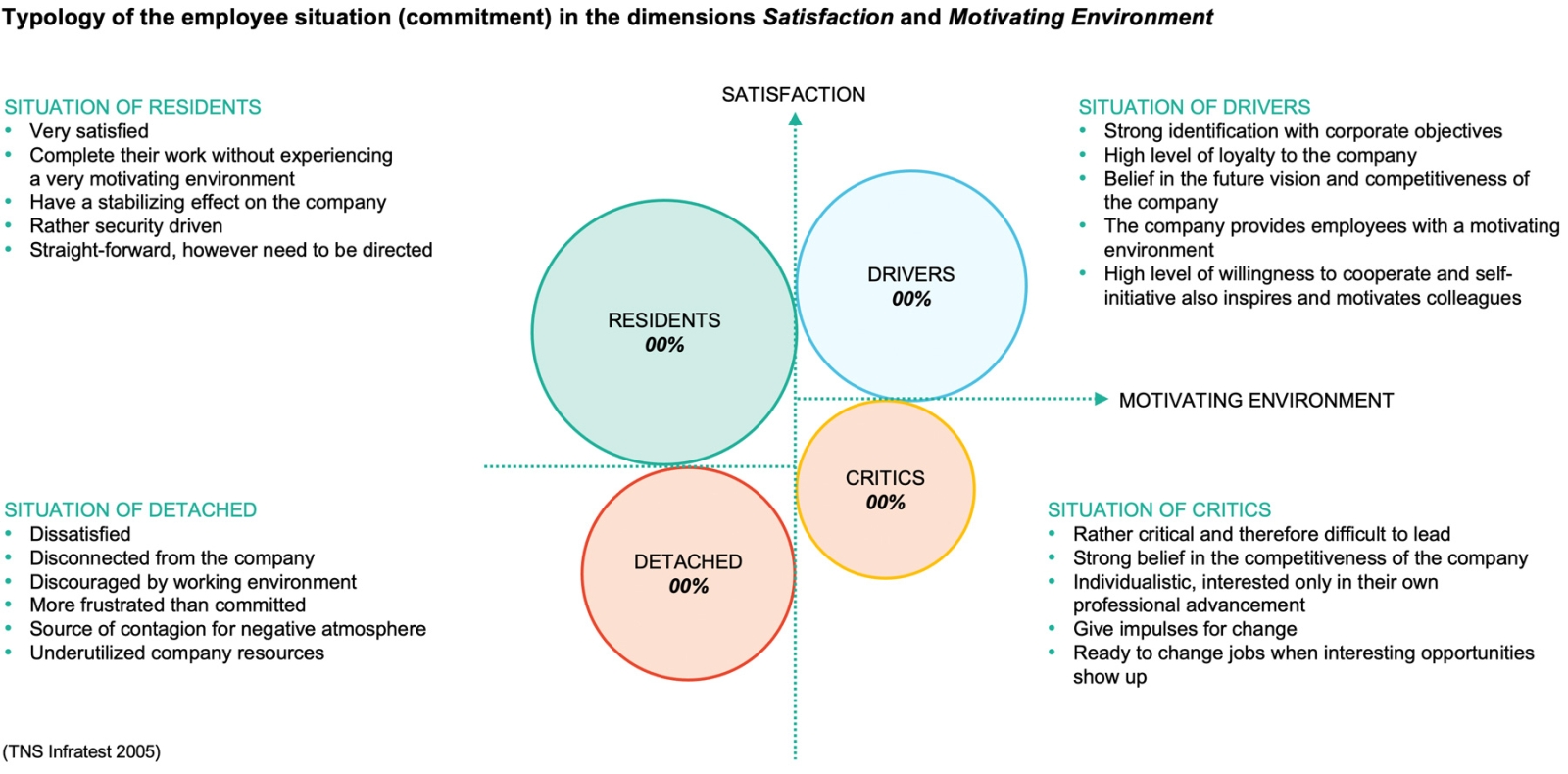Commitment Index

Guiding question
How strongly do employees support the company's goals and strategy?
Objectives
- Determine employees' readiness to support the company and its goals – especially during change
- Identify critical issues that stand in the way of employee support
- Identify stakeholders in the company who are willing to actively support the company's objectives
- Analyze strengths and weaknesses to derive and prioritize actions to improve engagement
Implementation
As a psychological construct, commitment eludes direct measurement. That is why the questionnaires of opinion research institutes target the drivers (components) of commitment – the Key Performance Indicators (KPIs). In the TRI*M Index concept developed by the opinion research institute TNS Infratest in the early 1990s, employees are asked 2 x 3 questions about the two main components of commitment – Satisfaction and Motivating environment (TNS Infratest 2005; cf. O'Gorman/Pirner 2005).
An index value (Commitment Index) is calculated from the answers to these six questions. It can be reported on a regional, divisional or departmental basis and can be benchmarked by comparing it with other companies in the same industry or country, for example.
The TRI*M typology explains the situation of employees within their working environment, and clusters them into the two main dimensions of Satisfaction and Motivating environment and according to their support potential into the types Drivers, Critics, Detached and Residents.
Another evaluation in four-field form (TRI*M Grid) indicates in three dimensions – Verbal importance of the quality element, Performance of the quality element and Impact of the quality element on commitment – indicates the likelihood of success of communicative and organizational measures to increase Commitment.
In the process, four fields – analogous to the TRI*M typology according to Motivators, Hidden opportunities, Potentials/Savers and Hygienics can be differentiated.
These are the working steps with the tool:
- The survey and roadmap for evaluation and follow-ups will be announced.
- The survey will be conducted.
- The survey results are published company-wide and in a cascade.
- In the area/team or region, the results are discussed and improvement measures are identified.
- Improvement measures are initiated.
Organizational commitment
Identification, for example of an employee with the company, can take place in three ways (cf. Felfe 2008):
- Affective. Emotional connection to an organization. The organization has great personal significance for the employee; he or she wants to belong to it in the future.
- Normative. Acceptance of organizational values as well as the employee's experienced (ethical) obligation to stay in the organization, e.g., because of the employee's training and development expenses.
- Calculative or continuation-based commitment (rational level). Switching costs when leaving the organization ("What do I expect if I remain in or leave the organization?").

Studies prove the positive correlation between Commitment and Performance, Motivation and Attendance at work. Negative correlations exist between Commitment and Stress, the Intention to leave the company and the Actually leaving the company.
Last but not least, there is a strong positive correlation between employees' commitment and their Readiness for Change. A strong achievement motive may manifest itself in extra-role behavior, for example: To what extent are employees willing to take initiative in addition to the tasks assigned to them? Initiative to take Commitment can therefore be considered a decisive driver for the Organization's ability to change. (Cf. Fuhlrott/Durst 2010)
Motivation and Trust in the company management are considered to be the two factors for Organizational commitment. Those who are motivated actively direct their behavior toward achieving a positively evaluated target state. What this target state looks like, however, depends on the personal motivational structure: While some people are more connection-motivated and value a good relationship with others, others are more performance-oriented and want to measure themselves successfully against standards of quality (ibid.).
Trust expresses – as a state between knowing and not knowing – the expectation in the behavior of others in the future but in a way is based on experiences in the past. As a “risky undertaking” it is “going beyond factual circumstances” and “achieves a relative independence from specific prior experience, from particular grounds for trust, something which has been termed ‘generalization’ in learning theory” (cf. Luhmann 1973/1979). In this respect Trust in the management of the company strengthens the Motivation of the employees and contributes to their Commitment and Willingness to change. Since the Trust in management also implies that employees "trust" their management to lead the company to success, employees' assessments of the Competitiveness of the company and their Assessment of the corporate strategy and, if necessary, also the Assessment of Management quality as indicators (Key Performance Indicators, KPIs) can be used for the measurement of Trust.
Other factors for Trust and Motivation – and thus for the Commitment – are the Knowledge of the employees about the strategy of their company as well as their Alignment with corporate goals, strategy and values.
Only if employees are aware of the company's goals and strategy and consider them to be promising will they actively support and achieve them through their Commitment – and through their Behavior (cf. Fuhlrott/Durst 2010).

